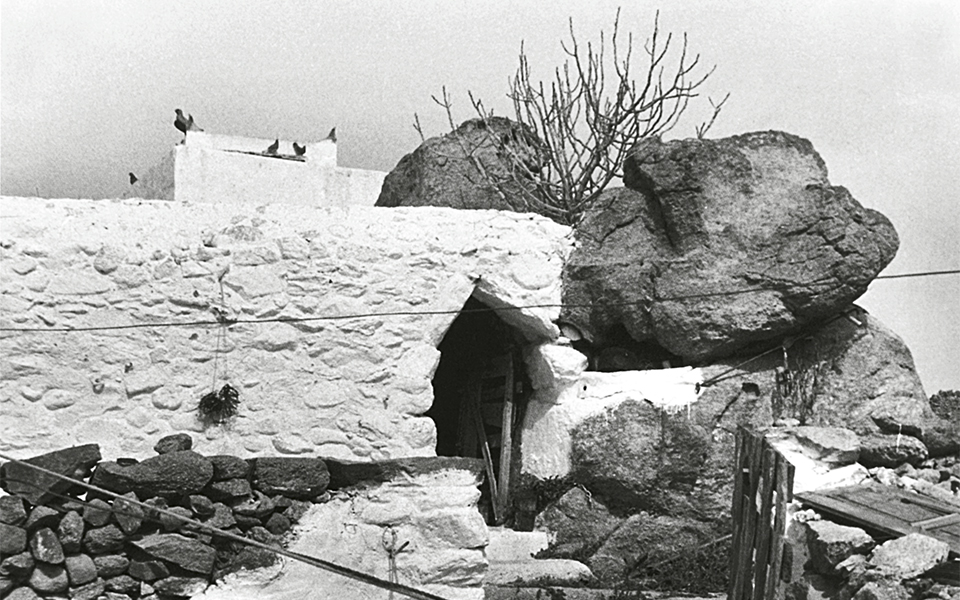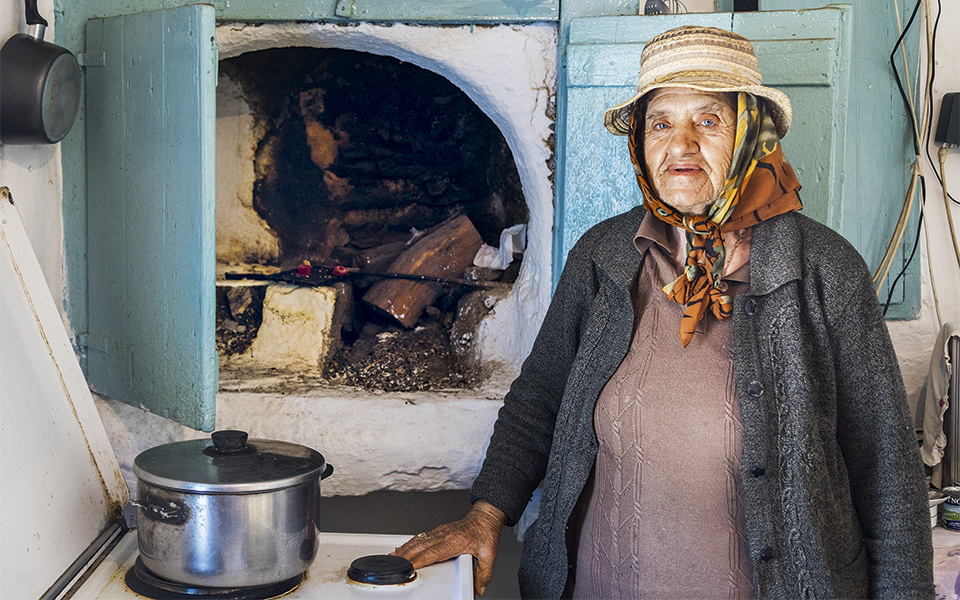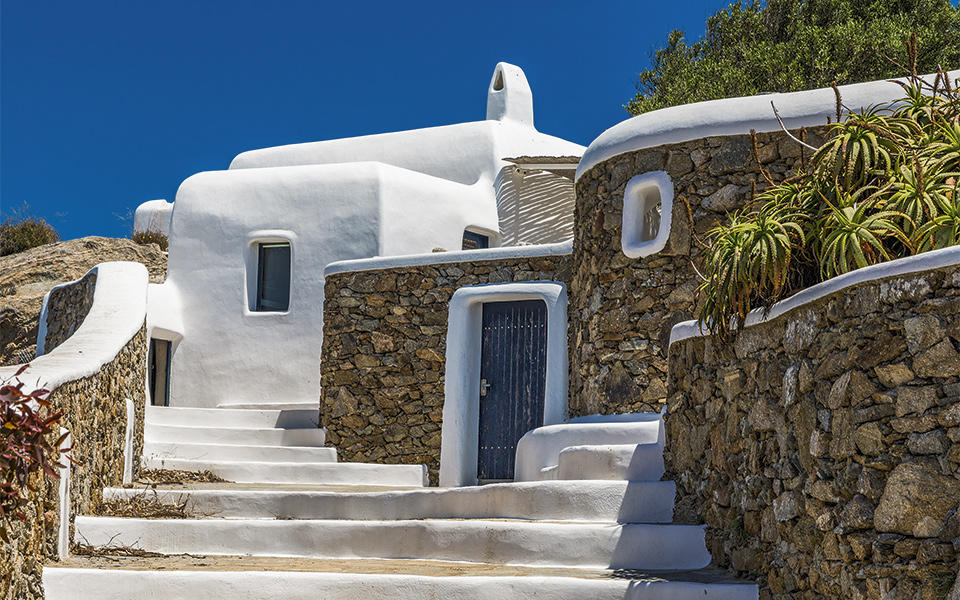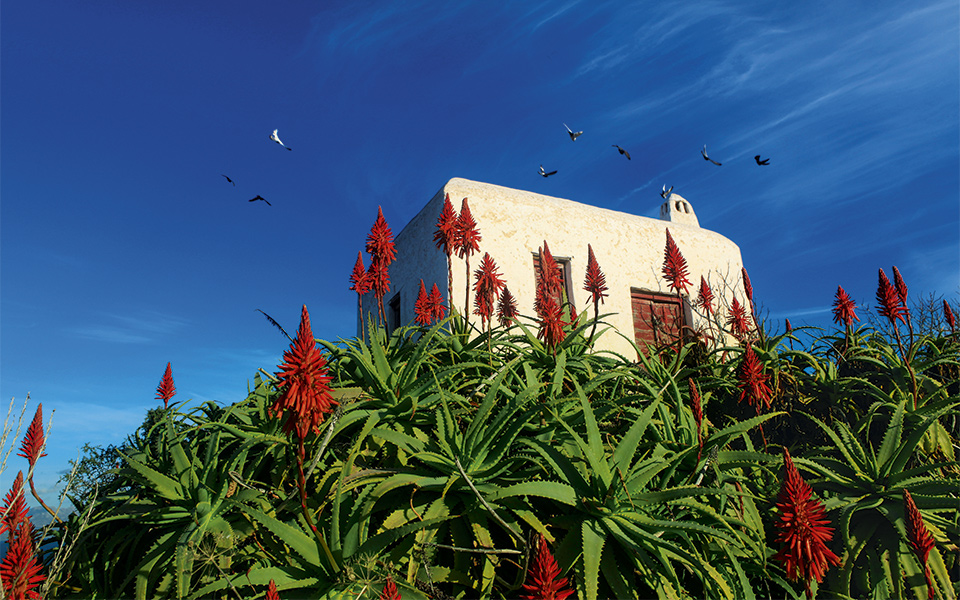When French architect and modernist pioneer Le Corbusier visited Mykonos in 1939, he remarked: “whatever architecture had to say, it is said here.” Would he say the same today if he were to visit? If he drove out into the countryside and searched frantically among the newly built villas and luxury hotels?
If he tried, then yes, perhaps he would still discern the typical Mykonian village through all the visual noise. At that point, some local would tell him that what they fondly refer to as a “little village” is not what the rest of the world describes as a settlement, but is, rather, a small universe created by rural families so they could live their lives with complete autonomy.
This “little village” is invariably built on the best spot of the family’s land, high up near a rock or hunkered down close to the land or in a garden, facing south so it gets good light and is sheltered from the strong northern winds. The most important feature is placed right at the front of the main house: the courtyard.
This is the main living area, where people spend most of their free time eating, sleeping and chatting away. The interior areas are cut off from each other and all their doors – the bedroom’s, the kitchen’s, the bakery’s and the barn’s – lead out into the courtyard.
The courtyard floor, comprising whatever material the ground consists of, and the bedrooms’, also made of natural materials like dirt, rock and lime, follow the natural contours of the ground. There is nothing more invigorating than emerging from the dusky interior, with its small slit windows, into the bright sunlight of the yard.

© Photographic Memento (1885-1985) By Panaghiotis Kousathanas
The simplicity of these “villages” mirrors the traditional way of life, as all a family’s day-to-day needs are accommodated in one space. The sleeping area is elevated on a wooden platform so that you feel safe in the embrace of the structure, a departure from the conventional layout of a bed and two night tables.
In the winter, food is served at the table in front of the sofa facing the entrance and the small windows, lending even more importance to the view outside. The dimensions are tight or, rather, just right to accommodate all the necessities. Wall niches are used to store food and utensils, while a shelf is placed above the door to keep bread and barley rusks.
At the same time, however, these are modern spaces made with expediency and wisdom, and when the family’s needs grow, so too does the farmstead, with the addition of more rooms, as necessity dictates, also around the courtyard.
There was a time when this farmstead was everything for the Mykonians. Rural families – the men, women and children – had to work tirelessly in their fields just to survive. Sunday was their only break, when they’d travel to Chora to go to church and buy whatever they couldn’t grow or make themselves. Each home was named after the family who lived there and, oddly enough, structure and people came to resemble each other.

© Perikles Merakos
The tourism boom, however, radically altered not just how these rural families lived but also the entire look of the island, and these “villages” – if not modernized, abandoned or demolished – became all but engulfed in the frenzy of new construction. It is easy to just pass them by. A few dozen locals continue to live in their ancestral homes, although these are mainly elderly residents who insist on the traditional way of life an a handful of younger folk who have modernized their family homesteads and use them as holiday homes.
The expression “I’m going to my village” has acquired a more abstract notion and means “I’m going to my ancestral home,” stressing the bond with family roots and the land rather than the type of dwelling. The significance of the “village” has without doubt been downgraded in recent decades.
The fields were turned into plots and luxury accommodation. Settlements sprang up along the coast and all sorts of buildings were erected haphazardly, in a way that does not suit the landscape. New buildings tend to be designed in the style perceived as “traditional” Cycladic architecture, and, while they may look pretty, they do not account for the island’s natural characteristics and serve abstract notions, such as comfort, luxury and view.

© Perikles Merakos
There are very few architects today who draw on the extensive knowledge, knowhow and vernacular of the traditional craftsmen who built the “villages.” Apostolos Nazos is one of them. “There has been a lot of debate in recent years regarding man’s relationship to the built environment, how he perceives his needs and how these are translated into the building and the environment.
How do you make a modern man live in a village? How does one sit on a stone wall? How does one sleep on a platform, touching the wall on one side? How do you dispense with the night tables and closet? How do you get a bathroom into every room when this is an area that belongs outside the house?” asks the architect.
“Back in the day, activity took place outside in the courtyard, in the field, on the land – without lights, without changes to the layout, without new materials, without smart houses and without the internet,” he says. “For all these unanswered questions, the ‘village’ reminds us of the need for the existence of the outdoors and the need for creating space that allows you to see the place in which you live.”
Special thanks to Mykonian architect Apostolos Nazos for his expertise and help











